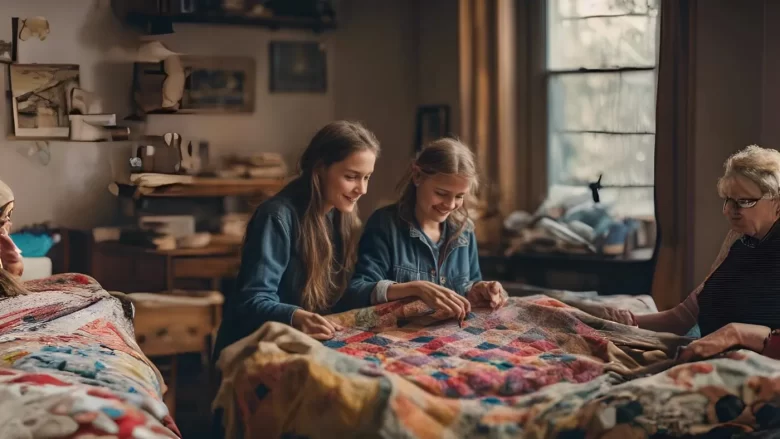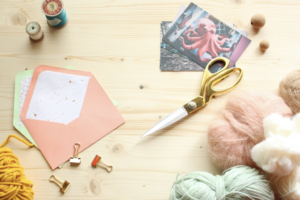Quilting is a centuries-old craft that combines art and functionality and has been used to decorate homes for many years. There are a wide variety of quilt patterns, from simple log cabins to more complex appliqués. These patterns can bring back memories, tell stories and make you feel better. Discover the world of padded comfort in this article. We’ll look at quilt patterns that have been around for a long time and continue to inspire experienced quilters and those new to this beloved craft.
1. Log Cabin Quilt Pattern:
The Log Cabin Quilt Pattern is a standard that will never go out of style. Quilters have loved it for hundreds of years. The pattern consists of strips of fabric arranged in a square or rectangle with a “block” in the center to resemble a home’s fireplace. This classic pattern represents comfort, warmth and the strong bonds between family members.
There are many color schemes and fabric types that can be used to make a log cabin quilt, allowing the quilter to customize the pattern to your liking. Whether you choose traditional earth tones or more modern colors, the log cabin pattern remains a classic and popular choice for quilted comfort.
2. Nine Patch Quilt Pattern:
The nine-panel quilt pattern is perfect for quilters of all levels because it is simple yet looks great. As the name suggests, the pattern consists of nine squares of equal size, grouped in a three-by-three grid. The blocks can be broken down into smaller parts, meaning there are countless possible color combinations and layouts.
The Nine Block Pattern can be used in many different ways to express your creativity. Quilters can experiment with different color combinations, solid colors and prints, or use patterns as the basis for more complex designs. It is popular in both classic and modern quilting projects because it has so many uses.
3. Star Quilt Patterns:
Star quilt patterns can be as simple and symmetrical as you like, or as complex and ornate as you like. They add a touch of divine elegance to sewing projects. The star pattern symbolizes hope and encourages artists to use their imagination.
The Zigzag Star, Ohio Star and Lone Star patterns are all common versions. These patterns allow quilters to demonstrate their skills in precision sewing and color selection. The star quilt is very beautiful and will always be loved by future generations, so many people keep it as a souvenir.
4. Quilting with Appliques:
When you appliqué, you can attach fabric shapes to the background fabric to create intricate patterns and designs. This method allows quilters to use many different patterns, from flowers and animals to geometric and personal symbols.
When you quilt with appliqué, you can do anything. You can use needle turn appliques, machine appliques, or fusible appliques to create your project. This approach makes it possible to tell stories through sewing. Through carefully selected appliqué elements, quilters can tell a story or commemorate a special memory.
5. Sampler Quilts:
Sample quilts celebrate diversity and creativity because many different quilt blocks are used in one project. Quilters can experiment with different styles and skill-building challenges by using different quilting patterns or methods for each square.
For new and professional quilters, sample quilts are a great way to add to their collection. There are many different types of building blocks, with traditional patterns, current designs and even experimental or improvised pieces. The result is a beautiful quilt that shows how the maker has grown and changed over time.
6. Cathedral Window Quilt:
Cathedral Window quilts are known for their intricate folds and folds, which make them appear three-dimensional and detailed. This design resembles the patterns on the stained glass windows of a cathedral, giving the quilt a sense of elegance and elegance.
Cathedral Window Quilts may seem difficult to make, but they are actually made using folding and hand sewing rather than standard piecing. Quilters can experiment with different color options to make the frame resemble a window. This can create a stunning effect that is both classic and modern.
7. Modern Quilt Patterns:
Modern quilt designs have become a vibrant and exciting trend in the quilting world. Modern quilts differ from traditional quilts because they use negative space, bold geometric shapes and colors that are not normally used together. They gave this age-old craft a new look.
Modern quilt patterns encourage quilters to experiment with techniques such as asymmetry, minimalism and improvisation. The emphasis is on personal expression, allowing quilters to break the rules of convention and still follow the basic rules of quilting comfort. Typically, modern quilts are large, statement pieces that can give any room a modern look.
Conclusion:
What makes quilted comfort so special is the quilting. They offer quilters plenty of room for creativity and self-expression. Quilters can draw inspiration from the rich history of the craft, whether they prefer the classic look of log cabin patterns, the stunning beauty of star quilts or the forward-thinking spirit of modern design.
When people take up quilting, they follow in the footsteps of artisans who created works of art from fabrics that transcend time and tradition. Behind every sewing pattern there is a story, and every stitch tells the story of how quilts have brought warmth, love and comfort to homes and hearts around the world. So assemble your fabrics, enjoy the beauty of quilted designs and create your own quilted comfort masterpiece.
FAQs:
1. What materials and tools are essential for someone who wants to start sewing different quilt patterns?
To quilt different patterns, you will need basic quilting supplies such as fabric, a cutting mat, a rotary cutter, a quilting ruler and a sewing machine. Specific patterns may require additional tools or techniques. Therefore, it is recommended to collect materials according to the chosen pattern.
2. Can a beginner try more complex patterns, such as cathedral windows or decals, or should they start with simpler designs?
Although beginners can try more complex patterns, it is generally recommended to start with simpler designs, such as nine patches or log cabins, to build fundamental skills. As confidence and experience grow, quilters can gradually develop more complex patterns.
3. How do I choose the right color scheme for my quilt pattern, especially for a design like a modern quilt pattern?
Choosing a color scheme comes down to personal preference, but with modern quilt patterns, bold and unconventional color choices are encouraged. Consider experimenting with contrasting colors, incorporating negative space and choosing shades that resonate with your personal style.
4. Are there any specific challenges or tips for incorporating appliqué elements into quilt patterns?
Stickers can be challenging for beginners, but starting with simpler shapes and using the fusible application method can make the process more manageable. Precision in cutting and sewing is critical, so take time to practice before incorporating your appliques into a larger project.
5. What is the point of making Sampler quilts?
How do they benefit quilters of different skill levels? A: Sampler quilts are good for quilters of all levels because they provide the opportunity to explore a variety of blocks and techniques in one project. For beginners, samplers provide an opportunity to build skills, while experienced quilters can use them as a creative outlet to demonstrate their mastery of a variety of patterns.


